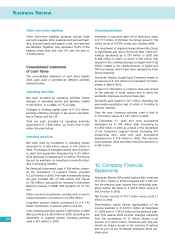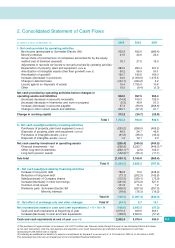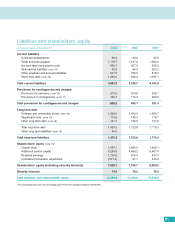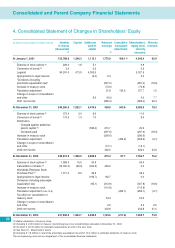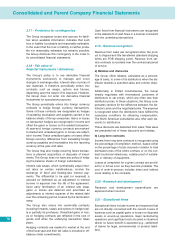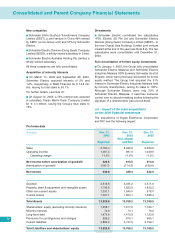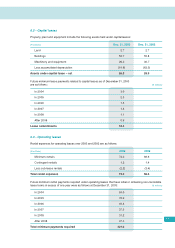APC 2003 Annual Report Download - page 70
Download and view the complete annual report
Please find page 70 of the 2003 APC annual report below. You can navigate through the pages in the report by either clicking on the pages listed below, or by using the keyword search tool below to find specific information within the annual report.
2.6 - Goodwill
Goodwill represents the excess of the cost of acqui-
sition over the fair value of assets acquired and lia-
bilities assumed at the date of acquisition. Goodwill
is amortized on a straight-line basis over the esti-
mated periods to be benefited not to exceed forty
years. When factors such as income, trends,
prospects and competition indicate that there may be
a potential loss in value in the related assets, the
Group evaluates if there is impairment of the value of
goodwill.
The specific indicator used to confirm the existence
and measure the amount of the impairment is
whether or not discounted cash flows from opera-
tions during the amortization period will be sufficient
to recover the carrying amount of the related assets.
2.7 - Intangible assets
Costs incurred by the Group in developing computer
software for internal use are generally expensed
when incurred. However for external and internal
costs related to implementing enterprise resource
planning (ERP) applications, such costs are deferred
and amortized over the period these applications are
used, which generally does not exceed five years.
Other intangible assets, other than brands, are amor-
tized on a straight-line basis over the periods to be
benefited or the period where such assets are pro-
tected by intellectual property laws.
2.8 - Property, plant and equipment
Land, buildings and equipment are recorded at cost.
Property, plant and equipment are depreciated on a
straight-line basis over the estimated useful lives of
the assets, as follows:
■Buildings 20 to 40 years
■Machinery and equipment 3 to 10 years
■Other 3 to 12 years
For operating fixed assets, the useful life is generally
defined as the period that is expected to benefit from
the operations of such fixed assets. However, when a
production line is scheduled to be halted or closed in
advance of the originally expected useful life, the
depreciation period is reduced.
When the Group enters into transactions that qualify
as capital leases, the leased assets are capitalized
and the related debt is recorded as a liability.
2.9 - Investments and marketable securities
Investments are reported at cost. Each year, the car-
rying value is compared to the recoverable amount
and the difference is recorded as an expense in the
consolidated statement of income.
The recoverable amount is determined by reference
to the Group’s equity in the underlying net assets, the
expected future profitability and business prospects
of the company and, in the case of listed securities,
the market value of the stock.
2.10 - Impairment of long-lived assets
For goodwill, an exceptional amortization charge is
recorded when the net book value exceeds the
recoverable amount, as measured by the discounted
free cash flow method.
For fixed assets including real estate and other non-
operating fixed assets, the Group has a policy of reg-
ularly reviewing the value of these assets for insur-
ance purposes and for comparison with market val-
ues of real estate. When those reviews show a per-
manent decline of market or insurance value over the
net book value, an impairment reserve is recorded
for the difference between the net book value and fair
value.
For other long-lived assets (including intangible
assets), management regularly receives third-party
appraisals, market valuations and other financial and
business based valuations. When these valuations
show a permanent reduction of the recoverable
amount over historical costs, impairment reserves
are taken or depreciation is recorded.
2.11 - Inventories and work in process
Inventories and work in process are stated at the
lower of cost (determined by the FIFO or weighted-
average methods) or estimated net realizable value.
The cost of work-in-process, semi-finished and fin-
ished products includes direct materials and labor
costs, subcontracting costs and production over-
head.
2.12 - Accounts receivable
An allowance for doubtful accounts is recorded when
it is probable that receivables will not be collected
and the amount is estimable. The identification of a
doubtful account as well as the related amount of the
provision are based on the analysis of our historical
experience of write-offs, the analysis of an aging
schedule, and a detailed assessment of specific
accounts receivable and related credit risks. Once it
is known with certainty that a doubtful account will
not be collected, the doubtful account and its related
allowance are written off against the reserve for
doubtful accounts.
Consolidated and Parent Company Financial Statements
68




